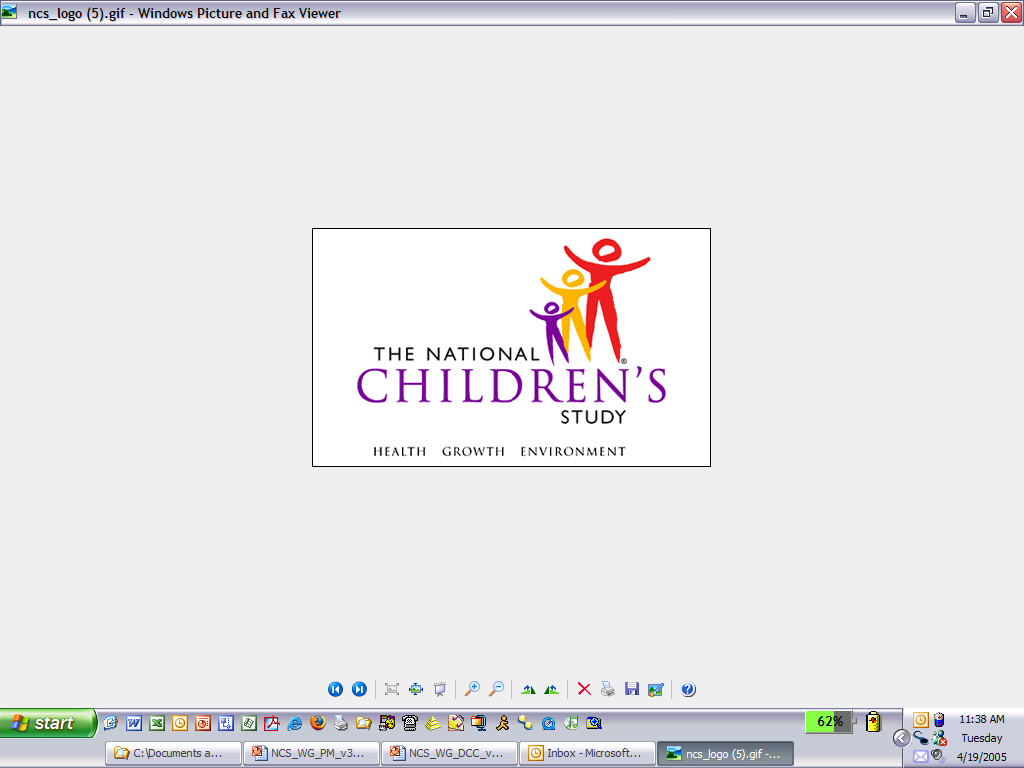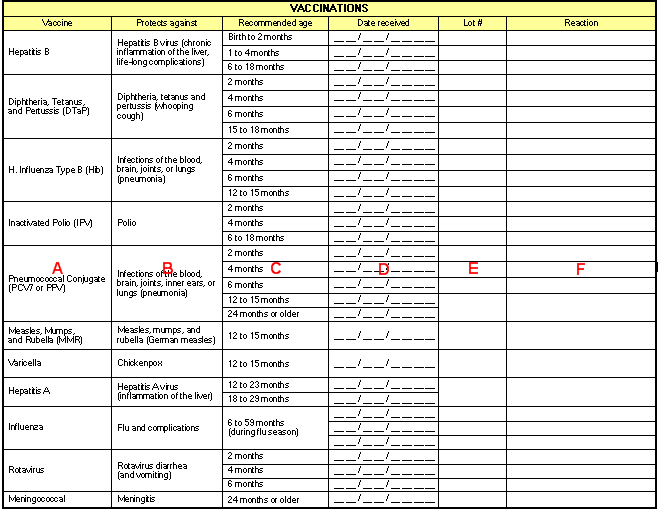1 Survey
Pilot Study for the National Children's Study (NICHD)
A.2.1.p Infant Medical Care Log
Postnatal Activities - Mother and Children
OMB: 0925-0593
Appendix A A.2.1.p–
OMB
#: 0925-xxxx
Expiration
Date: xx/xxxx
-

I
 nfant
Medical
nfant
Medical
Care Log
Infant Medical Care Log
The Infant Medical Care Log will help keep track of visits to doctors and other medical providers for your infant through 24 months of age. We will ask you about these visits during upcoming interviews. The log has two parts. The first part is for Routine / Well Visits and the other part is for Sick Visits. Please include visits to doctor’s offices, hospital emergency rooms and outpatient clinics, and any hospitalizations. Bring this Medical Care Log with you to each of your infant’s visits. If you forget to bring it with you to a visit, please complete the log as soon as possible afterwards.
Infant Medical Care Log
Instructions for Completing Vaccination section of Vaccination Log
|
You had noted in the Routine/Well Visit section of this log that your infant received a vaccination (or vaccinations) during his/her well visit and you had put a √ in the space provided for “Yes”. We also need the following information.
|
Routine / Well Visits |
|||||||
Reported to study staff |
Date of visit |
Name of medical provider |
Length / Height |
Weight |
Head circumference |
Vaccinations If Yes, complete vaccination page |
Problems, diagnoses, laboratory, and other findings
|
|
|
|
|
|
|
Yes
No |
|
|
|
|
|
|
|
Yes
No |
|
|
|
|
|
|
|
Yes
No |
|
|
|
|
|
|
|
Yes
No |
|
|
|
|
|
|
|
Yes
No |
|
|
|
|
|
|
|
Yes
No |
|
|
|
|
|
|
|
Yes
No |
|
SICK VISITS |
||||||
Reported to study staff |
Date of visit (include entire length of stay) |
LOCATION OF SICK VISIT |
|
|
||
Drs. office or clinic? |
Emergency Room (outpatient)? |
Hospital (inpatient)? |
Diagnosis? |
Treatments? |
||
|
|
|
|
|
|
|
|
|
|
|
|
|
|
|
|
|
|
|
|
|
|
|
|
|
|
|
|
|
|
|
|
|
|
|
|
|
|
|
|
|
|
|
|
|
|
|
|
|
|
|
|
|
|
|
|
|
|
|
|
|
|
|
|
|
|
|
|
|
|
VACCINATIONS |
|||||
Vaccine |
Protects against |
Recommended age |
Date received |
Lot # |
Reaction |
Hepatitis B |
Hepatitis B virus (chronic inflammation of the liver, life-long complications) |
Birth to 2 months |
__ __ / __ __ / __ __ __ __ |
|
|
1 to 4 months |
__ __ / __ __ / __ __ __ __ |
|
|
||
6 to 18 months |
__ __ / __ __ / __ __ __ __ |
|
|
||
Diphtheria, Tetanus, and Pertussis (DTaP) |
Diphtheria, tetanus and pertussis (whooping cough) |
2 months |
__ __ / __ __ / __ __ __ __ |
|
|
4 months |
__ __ / __ __ / __ __ __ __ |
|
|
||
6 months |
__ __ / __ __ / __ __ __ __ |
|
|
||
15 to 18 months |
__ __ / __ __ / __ __ __ __ |
|
|
||
H. Influenza Type B (Hib) |
Infections of the blood, brain, joints, or lungs (pneumonia) |
2 months |
__ __ / __ __ / __ __ __ __ |
|
|
4 months |
__ __ / __ __ / __ __ __ __ |
|
|
||
6 months |
__ __ / __ __ / __ __ __ __ |
|
|
||
12 to 15 months |
__ __ / __ __ / __ __ __ __ |
|
|
||
Inactivated Polio (IPV) |
Polio |
2 months |
__ __ / __ __ / __ __ __ __ |
|
|
4 months |
__ __ / __ __ / __ __ __ __ |
|
|
||
6 to 18 months |
__ __ / __ __ / __ __ __ __ |
|
|
||
Pneumococcal Conjugate (PCV7 or PPV) |
Infections of the blood, brain, joints, inner ears, or lungs (pneumonia) |
2 months |
__ __ / __ __ / __ __ __ __ |
|
|
4 months |
__ __ / __ __ / __ __ __ __ |
|
|
||
6 months |
__ __ / __ __ / __ __ __ __ |
|
|
||
12 to 15 months |
__ __ / __ __ / __ __ __ __ |
|
|
||
24 months or older |
__ __ / __ __ / __ __ __ __ |
||||
Measles, Mumps, and Rubella (MMR) |
Measles, mumps, and rubella (German measles) |
12 to 15 months |
__ __ / __ __ / __ __ __ __ |
|
|
Varicella |
Chickenpox |
12 to 15 months |
__ __ / __ __ / __ __ __ __ |
|
|
Hepatitis A |
Hepatitis A virus (inflammation of the liver) |
12 to 23 months |
__ __ / __ __ / __ __ __ __ |
|
|
18 to 29 months |
__ __ / __ __ / __ __ __ __ |
||||
Influenza |
Flu and complications |
6 to 59 months (during flu season) |
__ __ / __ __ / __ __ __ __ |
|
|
__ __ / __ __ / __ __ __ __ |
|
|
|||
__ __ / __ __ / __ __ __ __ |
|
|
|||
Rotavirus |
Rotavirus diarrhea (and vomiting) |
2 months |
__ __ / __ __ / __ __ __ __ |
|
|
4 months |
__ __ / __ __ / __ __ __ __ |
|
|
||
6 months |
__ __ / __ __ / __ __ __ __ |
|
|
||
Meningococcal |
Meningitis |
24 months or older |
__ __ / __ __ / __ __ __ __ |
|
|
Public
reporting burden for this collection of information is estimated to
average 20 minutes per response, including the time for reviewing
instructions, searching existing data sources, gathering and
maintaining the data needed, and completing and reviewing the
collection of information. An
agency may not conduct or sponsor, and a person is not required to
respond to, a collection of information unless it displays a
currently valid OMB control number.
Send comments regarding this burden estimate or any other aspect of
this collection of information, including suggestions for reducing
this burden, to: NIH, Project Clearance Branch, 6705 Rockledge
Drive, MSC 7974, Bethesda, MD 20892-7974, ATTN: PRA (0925-xxxx*).
Do not return the completed form to this address.
| File Type | application/msword |
| File Modified | 2008-09-19 |
| File Created | 2008-09-19 |
© 2025 OMB.report | Privacy Policy
 rite
in the visit date (month/day/year).
rite
in the visit date (month/day/year).
 rite
in the visit date (month/day/year). If the visit lasts longer
than a day, write in the entire length of the visit (i.e.,
10/2/2008 – 10/4/2008).
rite
in the visit date (month/day/year). If the visit lasts longer
than a day, write in the entire length of the visit (i.e.,
10/2/2008 – 10/4/2008).


